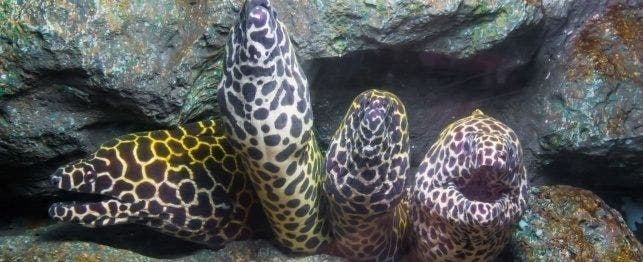
Choosing Marine Eels
Marine eels, of which there are about 20 families, make interesting displays in your tank but are usually kept on their own since, should they get the least bit hungry, they’ll most likely eat everyone else.
Eels are nocturnal fish that live in caves and holes along a reef, snatching any hapless fish drifting by. In nature, eels will eat just about anything, and in captivity, they’ll do the same, as long as it’s meaty. Some eels even have an evolved ability to crush shells, so even clams aren’t safe from the powerful jaws of a species such as the moray, the most common eel for hobbyists.
Chopped fish, shrimp or live fish will do fine as a regular diet. For eels, squid are a delicacy, so be sure to treat your moray to some raw calamari once in awhile. Some people hand-feed their morays, but watch your fingers. These eels locate food with their sense of smell – not sight. The bite of a moray is vicious. Their jaws clamp down and don’t let go easily. Use a long tweezers to place food in front of their mouth – to train them to eat. Later you can just drop the food in and they’ll get it. They can and often do go for several weeks without food, particularly during the adaptation period.
Varieties of Moray Eels
- Common moray. Gymnothorax kidako is easy to keep, especially because it doesn’t reach nearly the lengths of its exotic relatives. This eel usually gets no longer than 30 inches. When a store gets them, they’re usually at about eight inches. They can be kept with other fish, as long as their tankmates aren’t bite-sized. It is suggested to keep this eel in a 100-gallon tank.
- Chainlink moray. Echidna catenata is a black and white spotted eel This eel gets to be around five feet long, even in captivity, so if you keep one make sure to have ample room – no less than a 200-gallon tank. These are native to the Indo-Pacific and if you can get them to be happy with the diet, they are fairly easy to keep.
- Leopard eel. Gymnothorax sp is also relatively easy to keep. It has a coloration similar to that of a leopard, dark brown and black splotches arranged on a beige-yellow background. The Hawaiian leopard eel is easily distinguished by its more circular spots, giving it its local name of clown eel. This species obtains sizes of about 30 inches so a 100-gallon tank is recommended.
- Zebra eel. Gymnomuraena zebra is a very popular species for eel hobbyists. It is striped white on a golden brown background. Like others in its family, it is easy to keep especially if you feed it plenty of crabmeat, which it gets in its natural environment. These eels come from the eastern Pacific region. They grow to be about 40 inches in length and require at least a 100-gallon tank. They, like the others, can be kept with other fish as long as they’re not small enough to snack on.